|
|
Partisan

|
|
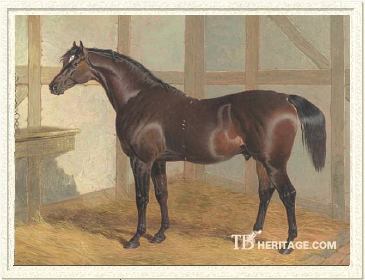 |
|
|
Partisan was a moderately good race horse who established a long-lasting sire line in Europe and England. He got several sons who exceeded his accomplishments on the turf, and three sons who sent the Highflyer sire line forward. Of the good daughters and producers that sprang from his sons, two, Queen Mary and Queen Bertha, had a significant influence on the breed.
Partisan and his offspring ran during the nadir of English racing, when the sport was operating with Jockey Club rules irregularly enforced at Newmarket and often ignored in other venues. With the increasing number of "open" races -- those not limited to Jockey Club members -- and the influx of many participants for whom the sole object was winning through wagering, instances of bribes, fraud, tampering with horses, and violence had been on the increase since the late 18th century. Some of the owners noted here -- John Gully and Robert Ridsdale -- were participants skating on the edge of these practices; others, such as Lord George Bentinck, the third son of the fourth Duke of Portland, introduced improvements that made such practices less possible, after benefiting from them in his early years on the turf. Bentinck was instrumental in exposing the 1844 Derby fraud, in which a four-year-old son of Gladiator (by Partisan) was substituted for a three-year-old known as Running Rein, and subsequently won the Derby. A Partisan son, Glaucus, was probably the top two year old of his year, and was then sold to gambler Robert Ridsdale, who ran a vast network of corruption amongst grooms, which he had once been, trainers and jockeys. Glaucus, odds-on favorite for the Derby the next year, did not place, nor did he place in the St. Leger, his only other race that year. After his sale to the upstanding, if feckless, George Stanhope, 6th Earl Chesterfield, Glaucus returned, at age 4, to his winning ways on the turf. The history of the horses running during these years should be read with this larger context in mind.
|
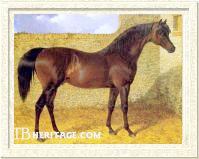
Walton was a sire of sires
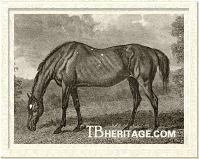
Parasol produced Partisan and 2 classic winners
| |
Walton was a good racehorse who was best at distances between two and four miles, winning the Oatlands handicap at Newmarket at age four, and won or placed in a number of King's Plates, matches, and stakes races over two, three and four miles at age five and six. He was a sturdy, heavily-muscled horse and passed on his looks to many of his progeny. He was a popular and successful sire of two Derby winners, and led the sire's list in England twice, in 1816 and 1818. He produced three top sire sons -- Derby winner Phantom, who got two Derby winners and dual-classic winner Cobweb, later a top broodmare; Rainbow, a good stakes winner who became a top sire in France, and Partisan, who carried the Sir Peter Teazle branch of the Highflyer sire line forward into the late 19th century.
One of the horses Walton met several times on the turf was the bay mare Parasol, who bested him several times in races at Newmarket. Bred and owned by the George Henry Fitzroy, 4th Duke of Grafton, she was born in 1800, out of the top broodmare Prunella and by Pot-8-Os. Parasol was a very good race mare who won 31 matches, plates, handicaps and stakes against both sexes over her six year career on the turf. Her best wins included the Oatlands handicap in 1804, the Jockey Club Plate in 1805, beating Walton and others in a canter, and a match against the 1805 Derby winner Cardinal Beaufort, in which she gave him 17 pounds.
|
Parasol was retired to the Duke of Grafton's stud at age eight. Her first foal was Parachute, a chestnut colt by Sorcerer, born in 1809, who was not successful on the turf. To the cover of her challenger on the turf, Walton, Parasol dropped her second, a bay filly named Promise, who was sent to Ireland, where she bred some good foals. Bred back to Walton, Parasol produced her third foal, a bright bay colt named Partisan, in 1811, for the Grafton stud. She went on to produce nine more foals for the Grafton stud, most to the cover of Highflyer line sires. Her last, Paramour, a colt by Merlin, was born in 1824. In 1826, age twenty-six, she was bred to 1818 Derby winner Sam, but in the fall of that year, apparently ill and suffering, she was shot. Among the winners she produced were Pindarrie (1820, by Derby winner Phantom -- a Walton son), winner of the 2,000 Guineas, and Oaks and 2,000 Guineas winner Pastille (1819, by three-time leading sire Rubens). Pastille became a good producer after her retirement to stud. Pindarrie was sold to India.
Partisan resembled his sire, Walton, with heavy muscling and a powerful shoulder and hind end, but his frame was lighter, and, unlike his somewhat sickle-hocked sire, he was straight behind. His left forefoot was described as "somewhat clubby." He got his sire's refined head and large eye. At 15.2 hands, he stood over a deal of ground, with his long back and short legs. "The trainers of his day, one and all, were wont to refer to him with much fondness, as being like a piece of machinery in action." Unlike his sire, he was known more for his speed than his stamina, most likely inherited from his dam.
Partisan on the Turf
Partisan's first season on the turf, at age 3, was moderately promising. He was nominated for the Derby, but did not run, his trainer, Robert Robson, electing not to run him in the classic because he was unable to get him into condition, due to a long, hard winter. He ran seven times that year, winning three 200 guineas matches at Newmarket over the course of the season, first against another Walton son, the undistinguished Pinions, next against the better Magician, by Sorcerer, and a third match against an Orville filly. In a match against the Selim colt Little Turk, he received a forfeit. Early in the season he ran unplaced in a three-year-old sweep, won by Bourbon, and in July ran unplaced in the Newmarket Town Plate. By October, he was beginning to show his form, winning a sweep at Newmarket, beating the older Curlew, and the good race filly Medora, who had won the Oaks that year.
At age four he started three times, all races at Newmarket, and won twice, placing second once. He won a match against the four year old filly Scheherazade, and followed that up with a win against some other good four year olds, including Bourbon (winner of the Claret and Craven Stakes) and Osman. He placed second in the Garden Stakes, beaten by the three-year-old Orville. At age five he ran twice, beating the favored Bourbon and three others in a race at Newmarket. He ran once more, without success, and then was retired to the Grafton stud.
The Duke of Grafton's trainer, Robert Robson, is credited with elevating the status of race horse trainers from that of "glorified groom" to that of professional. He resisted a number of common practices, including starting horses on the turf at age 2 and the use of blankets and rugs in training. He had a reputation for "delicate handling" of his charges, but even with this, one does have to wonder regarding Partisan's light schedule at ages four and five, particularly when the careers of his sire, Walton, and his dam, Parasol are examined. There is no mention of Partisan himself being "delicate," but his son, Gladiator, appears to have only run twice, although other offspring of Partisan raced longer and harder than their sire.
Partisan in the Stud
Although he never led the sire's list, Partisan proved to be a highly influential sire. He got four classic winners -- 1821 1,000 Guineas winner Zeal, 1827 Derby winner Mameluke, 2,000 Guineas winner Patron, and Oaks winner Cyprian -- and three exceptionally successful sire sons, Gladiator, Glaucus, and Venison. He got a good many daughters who bred on, but only a few were immediately successful dams of classic winners.
|
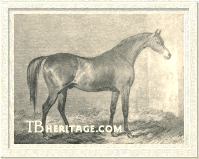
Godolphin sired a classic-winning daughter.
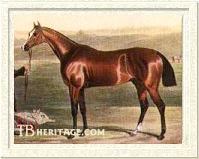
Mameluke won the Derby.
| | GODOLPHIN (1818) was an attractive red bay colt out of Ridicule, by Shuttle. Sold to Lord George Cavendish, he ran between the ages of three and five in good company. His only win at age three was a forfeit match for 300 guineas from Tressalian, but he ran second for the Gold Cup at Newmarket Craven to Sultan, and second to Augusta in the Newmarket St. Leger, beating that year's 2,000 Guineas winner Reginald. At age four he won Newmarket's Craven Stakes, beating a field of fifteen, and some sweepstakes and matches. At age five he failed to win in his two starts, which included a match race with Sultan. Retired to the Cavendish stud, he was a moderately successful sire. His daughter, an unnamed filly out of Mouse won the 1,000 Guineas, and his son, Mazeppa (1827, out of a Rubens mare) was a good winner on the turf for five years, especially at distances over two miles; his wins included Cheltenham's Glocestershire Stakes, the Oxford Cup, a cup at Abingdon (twice), and other races at second and third-tier venues, but he placed second in a number of good races against top company as well, including the Oatlands handicap.
|
Owned by the Earl of Jersey, MAMELUKE (1824) was out of Miss Sophia by Stamford (a son of Sir Peter Teazle). He debuted in the Riddlesworth Stakes for three-year-olds; this was the race won by the Phantom son Glenartney, an unnamed daughter of Partisan out of Donna Clara placing first, but disqualified for being under-weighted. Mameluke ran second, but was not placed in what many considered a bad judge's call. Mameluke then received a forfeit in a match race at Newmarket, followed by the Derby, which he won by a length, beating Glenartney and the 2,000 Guineas winner Turcoman.
Following his Derby win Mameluke was sold for £4,000 to the former prizefighter and bookmaker, John Gully, who soon thereafter formed a racing partnership with Robert Ridsdale, and subsequently with the unscruplous Harry Hill. Mameluke's next race, the St. Leger at Doncaster, was, like the Derby, also clouded--there were a number of false starts, and gossip later alleged that they were deliberate, to unsettle Mameluke, which they did. When the field finally got underway, he was left sixty yard behind, but with great courage he managed to catch the leaders, only to fail by half a length at the end of the race. That was enough for Mameluke for his first season.
In his four year old year, Mameluke began by winning the Oatlands handicap, followed by a win of the Port Stakes, beating his sole opponent, Amphion (also by Partisan). He received a forfeit for a race against the filly Babel at Newmarket, and then ran in the Doncaster Cup, unplaced. In his third season he won a match against Rough Robin at Newmarket, and at the end of the season challenged for The Whip, which he won, beating Lamplighter, followed by a win of a handicap (high weight) at Newmarket. In between, he placed second in the Ascot Gold Cup to the good colt Zinganee, and beating a top field; and a heart-breaking second in the Goodwood Cup, won by the great race mare Fleur-de-Lis. He was unplaced once, in the Garden Stakes at Newmarket.
Mameluke was sold to William Theobald, who retired him to his Stockwell stud farm in Surrey. He was not a particularly successful sire: the French race horse and sire Le Pompon (1891 by Fripon) descended from a daughter, Cochlea (1840). He did, however, get Myrtle (1834), out of the great race mare and Ascot Gold Cup winner Bobadilla. Myrtle was sent to the U.S., where she produced Magnolia to Glencoe. Magnolia founded a good female line in the U.S., which included her immediate foals, Daniel Boone (1856) and Kentucky (1861), and more distant tail-female descendants, such as Herold (1876, Kentucky Derby winner), Sir Dixon (1885, Belmont Stakes winner), Panique (1881, Belmont Stakes), the U.S.-bred horse Iroquois, who won the both the Epsom Derby and the Doncaster St. Leger, and the great U.S. handicap horse, Whisk Broom (1907).
The bay GLAUCUS was born in 1830, out of the Selim mare Nanine, and ran in the Grosvenor colors during his successful two-year-old season. Sold to gambler/owner Robert Ridsdale, he failed to place in his two starts at age three--the Epsom Derby and the St. Leger. Purchased by the Earl of Chesterfield, at age four he returned to his winning form with victories in the Claret Stakes, the Ascot Gold Cup, a 2-1/2 mile Jockey Club Cup race at Newmarket, and a 3 mile-5 furlong race at Goodwood; at the end of that season his owner challenged for the Whip, and took it unopposed. In his last two seasons he won the Goodwood Stakes, the Hornby Castle Stakes, and walked-over for two races at Newmarket. In the stud he got two classic-winning daughters, and The Nob, a good stayer, whose son, The Nabob, took the Partisan sire line to France, where it flourished through Bois Roussel (1861), Suzerain (1865) and Vermout (1861).
|
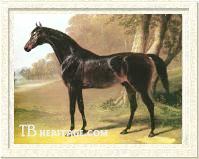
Glaucus
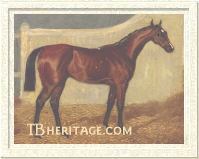
Partisan's classic-winning daughter Cyprian
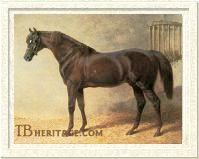
Gladiator sired top horses in England and France
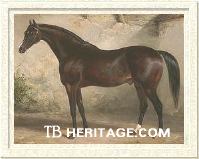
The courageous and tough Venison got classic winners
| | Partisan's daughter CYPRIAN was a bay filly bred and owned by the highly successful northern trainer John Scott, who in the course of his forty-six year career trained forty-one classic winners for the wealthy of England, including the Earls of Derby, the Earl of Chesterfield, John Bowes, and the Marquis of Westminster. Cyprian was born in 1833, out of the Filho da Puta mare, Frailty. She debuted at age 2, running third in a sweepstakes at Northallerton. Scott then put her away until the spring of her three-year-old year, when she won her first race of the season on home turf at the Malton Meeting, a sweepstakes for fillies. Her next race was the Epsom Oaks, which she entered as a favorite, and did not disappoint, winning by half a length over the good filly Destiny, under a punishing ride from Scott's jockey brother, William. Scott sold her to one of his owners, John Bowes of Streatlam, County Durham. In the Bowes colors she won the Northumberland Plate at Newcastle, beating older horses. She passed into Richard Singleton's hands, and ran for him in the Craven Stakes at York in 1837, but could only run third. She was retired to stud in Scott's ownership, "a good and honest mare, whose success was hardly equal to her merits."
In the stud she produced Oaks winner SONGSTRESS (1849, by Birdcatcher), and the decent racing colts Joe Lovell (1841), who won the Great Yorkshire Stakes, The Artful Dodger, Tom Tulloch, and Parthian. Her daughter, Miss Horewood (1838, by The Saddler), produced 2,000 Guineas winner Pittsford (1847, by Epirus). Another daughter, Cypriana (1852, by Epirus), bred on: U.S. champion 3 year old colt of 1899, Ethelbert, was a tail-female descendant.
GLADIATOR (1833), from Pauline, by Moses, ran second to Bay Middleton in the 1836 Derby. He was an influential sire in both England and France, getting Sweetmeat, a winner of the Doncaster Cup and a sire of classic winners, and the important broodmare Queen Mary, dam Bonnie Scotland, a leading sire in the U.S., and of dual-classic winner Blink Bonny, herself dam of Derby winner Blair Athol. In France Gladiator got a number of classic winners and sire sons who bred on, notably Fitz Gladiator and Ventre St. Gris. His daughter, Miss Gladiator, produced the great French-bred winner of the English Triple Crown, Gladiateur.
VENISON was Partisan's last influential son, one of that amazing crop of 1833. He was small, and by all accounts, a beautiful horse with "...an exquisite tapered head, small ears, and prominent eyes, full of fire." He inherited his sire's beautiful action, and, according to the turf writer, The Druid,"...a gamer or more gentlemanly little horse never cantered down the cords."
|
Venison's dam, Fawn (1823) was by Smolensko and out of Jerboa, by Gohanna, from whom he was said to have gotten his small size. Purchased as a yearling for £100 at a "weeding out sale" by the jockey-turned-trainer John Day, he started once at age two, placing second, in the Lavant Stakes at Goodwood.
He began his long three year old campaign with the Derby, in which he ran third to Bay Middleton and Gladiator. After that, he racked up a series of wins: the Glocestershire Stakes at Cheltenham; the Gold Cup over three miles; the Gold Cup Stakes at Southampton in a walk-over; the King's Guineas at Goodwood over three miles-five furlongs; the Brighton Stakes, beating 1834 Oaks winner Pussy and five others; a walk over for the King's Plate at Lewes; two races at Warwick, one a King's Plate; two races at Lichfield, including the Member's Purse and a sweep; a King's Guineas race in two mile heats; a four mile King's Plate at Doncaster, beating the 1835 Derby winner Mundig. His string of victories ended with the Doncaster Cup, in which he placed third to Carew and Beeswing, but he followed that by winning his last race of his very long season, theTown Plate.
At age four he started with a walk over for a sweep at Newmarket Craven, followed by winning a handicap sweep over three miles at Newmarket First Spring. The day after that win, he won the King's Guineas over three miles-four furlongs. At Reigate, he ran second to Slane in the Dinner Stakes. At Ascot he won the King's Plate. He won the Mottisfont Stakes at Stockbridge in a walk over, the last contest of that season. He was sold to Lord George Bentinck, who started him once, at Stockbridge in the Mottisfont Stakes in 1838: "His Turf finish," said the Druid, "was right worthy of him. He carried 9 st. 6 lb. at Stockbridge, and broke down three-quarters of a mile from home: but, thanks to the careful nursing of young John Day, he finished fourth, with his head at the winner's girths."
Unlike his sire, Partisan, and his crop-mate, Gladiator, Venison thrived on work; he was kept in condition, it was said, by "tramping from one racecourse to another." He was known for his stoutness, and for his courage. He passed on his beautiful head and eye, and "cross him as you might, nearly all his stock came small, with grey hairs in their coat." His son, Kingston (1849, from Queen Anne by Slane), was called the "Knight of the Silver Hair;" he won the Goodwood Cup, and in the breeding shed he got Derby winner Caractacus (1859) and Oaks winner Queen Bertha (1860), who produced two dual-classic winning daughters.
Venison also sired The Ugly Buck (1841, 2,000 Guineas), Clementina (1844, from Cobweb by Phantom, winner of the 1,000 Guineas), and Miami (1844, from Diversion, by Defence, winner of the Epsom Oaks). Both Clementina and Miami bred on. Miami was second dam of Oaks winner Marie Stuart (1870), and was tail-female ancestress to the sire White Eagle (1905), the top late 19th century race mare Merry Gal (1897), and Morganette (1884), the dam of Derby winner Ard Patrick, Irish Derby winner Blairfinde, and English Triple Crown winner Galtee More.
Another Venison son, Alarm (1833, from the Defence mare Southdown) won both the Ascot Gold Cup and the Cambridgeshire Stakes. His daughter Torment (out of a mare by Glencoe) was dam of Oaks winner Tormenter, and second dam of Petrarch (1873), who won the 2,000 Guineas, the St. Leger, and the Ascot Gold Cup, among other races. Several of Alarm's sons sired top steeplechasers: Commotion (1854) got Grand National winner Disturbance; Compromise (1855) got Grand Steeple-chase de Paris winner Congress; Fright (1854) was the grandsire of Irish Grand National winner Castle Lucas . Alarm's son Panic, sent to Australia, sired Melbourne Cup winner Nimblefoot.
Another son of Partisan's, RAPID RHONE, won the Grand Duke Michael Stakes in 1827, and the Claret Stakes at Newmarket in 1828. Partisan's son, ODIN (1830) was exported to Norway, where he became a foundation sire of trotting horses in Norway and Sweden.
Partisan was a moderately successful broodmare sire. He was bred to the Selim mare Quadrille several times. She produced two good sisters by him. CONSTANCE (1835), was dam of Oaks winner Catherine Hayes (1850, by Lanercost), and, through her, second dam of the sire Belladrum and of the producer Cantata. COTILLION (1831), fourth dam of Irish Derby winner Billy Pitt and of Flora McIvor, to whom many good Australasian horses traced, including leading New Zealand sire Trenton, whose daughters are tail-female to Bull Lea and Gainsborough. Her daughter, Pauline, by Moses, when bred to Partisan, produced Gladiator.
An unnamed DAUGHTER born in 1834 from Pomona was the dam of 1,000 Guineas winner Sorrella (1841, by The Saddler), who was tail-female to some good stakes winners, including 1887 Irish Derby winner Wales. Sorrella's sister, Martingale (1840) was tail-female ancestress to classic winners in Austria and Hungary.
Other Partisan daughters who bred on included ALLY (1818), dam of the fair sire Nuncio (1839, by Plenipotentiary). MONA (1819, from Patriot daughter Miltonia), was third dam of 1855 1,000 Guineas winner Habena. SOLA (1822, from a Whalebone mare) was fifth dam of Signorina (1887, by St. Simon), who was the dam of Derby and Oaks winner Signorinetta, and of Signorino and Star of Naples. SCUFFLE (1829, from Scratch by Selim) established a strong female family leading to the good stakes winner, and later sire, Kaiser (1870, by Skirmisher), to Uncle Mac (1894, by Hagioscope) who won the Chester Cup and other good races, and to 1911 Argentine Oaks winner Pirita. ACTIVE (1820), from Derby and Oaks winner Eleanor, by Whiskey, second dam of the moderately succesful Father Thames (1849), and fourth dam of U.S. stakes winner Springbok. FLORA (1829, from Fatima by Selim), was second dam of Lady Orford, who won the 1,000 Guineas. FRANCESCA (1829, from an Orville mare), was second dam of the good sire Adventurer (1859), by Newminster. DIRCE (1830, from Whalebone daughter Antiope), was third dam of the good in-bred French racehorses and sires, Vermout (1861, by The Nabob, see above) and Vertugadin (1862, by Fitz-Gladiator), and was also tail-female ancestress of the important sire Bay Ronald (1893, by Hampton).
--Patricia Erigero
|
|
|
|

